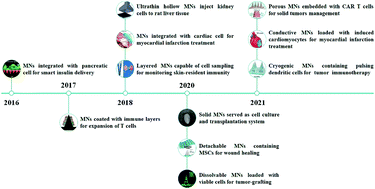Microneedle-based technology for cell therapy: current status and future directions
Abstract
With the growing technological innovations in medical treatments, cell-based therapies hold great potential as efficient tools against various previously incurable diseases by restoring or altering the function of certain sets of cells. Along this line, an essential factor to determine the success of cell therapy is the choice of cell delivery strategy. In recent years, a novel trend is blooming in the application of microneedle systems, which are based on the miniaturization of multiple needles within a patch to the micrometer dimensions, aimed at the delivery of therapeutic cells to the target site with high efficiency and in a minimally invasive manner. This review aims to demonstrate the advantages of exploiting microneedle-based technology as a new tool for cell therapy. The advancements of microneedle-based strategies for cell delivery are summarized in terms of two categories: cell-free and cell-loaded microneedle systems. The majority of research on microneedle-based cell therapy has shown promising results for tissue regeneration, cancer immunotherapy, skin immune monitoring and targeted cell delivery. Finally, current challenges and future perspectives toward the development and application of microneedles for cell therapy are also discussed.



 Please wait while we load your content...
Please wait while we load your content...